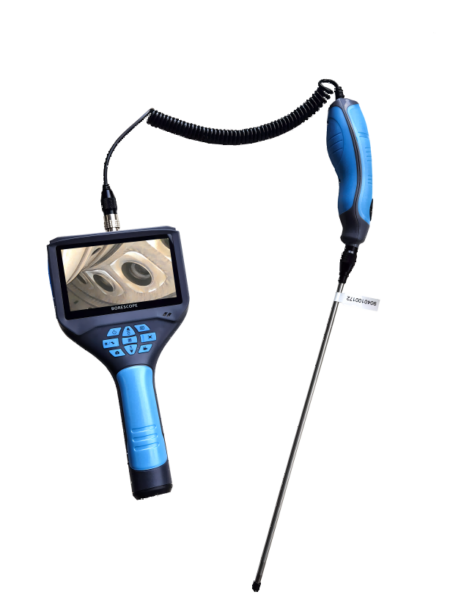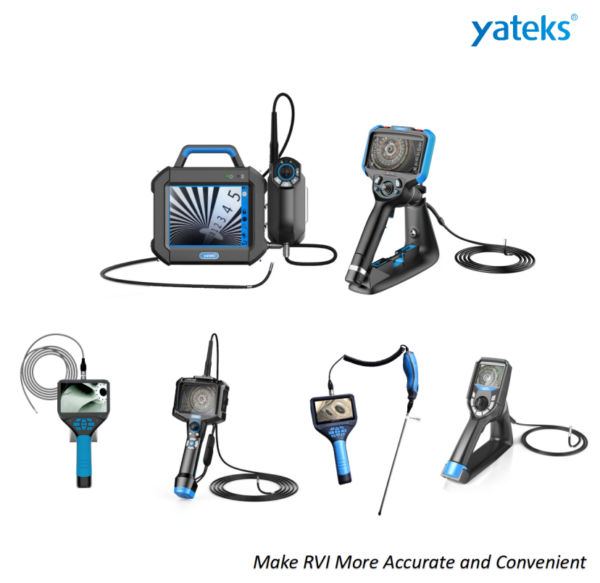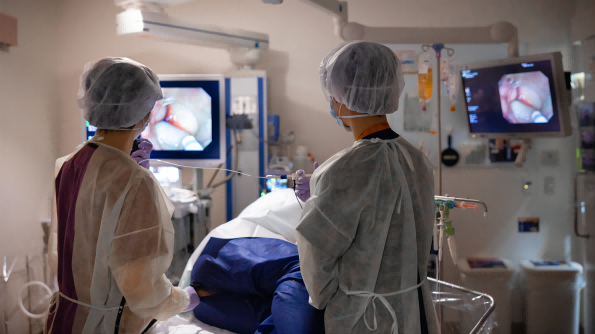Usually, many people can’t distinguish between a borescope and an endoscope. endoscope appeared earlier, and a borescope was produced based on the endoscope. Their basic principles are the same, and they can also be divided into rigid tube endoscopes, fiber endoscopes, and electronic endoscopes according to their development and imaging structure classification. So what is the difference between a borescope and an endoscope? This article will give you a detailed answer.
What is a borescope?
Borescope inspection is a kind of visual inspection in nondestructive testing. The biggest difference between borescope and other nondestructive testing methods is that it can directly reflect the internal and external surfaces of the inspected object (such as cracks, burrs, welds, and other internal surface qualities) without disassembling the inspected object.
At the time of detection, we can use borescope equipment to record the whole detection process dynamically by video or photo. It can also quantitatively analyze the defects found and measure the length and area of the defects.
What are the classifications of borescopes?
Here are three main types of borescopes: Flexible borescopes, video borescopes,Rigid borescopes
Flexible borescope
The flexible borescope is also called a fiber camera. It uses coherent optical fiber bundles to send images back to inspectors. The fiber borescope is flexible and small in size, which is very suitable for remote endoscopic detection of narrow areas of key equipment, engines, and infrastructure. It supports video recording and has various diameters and lengths to choose from.
Video borescope
A video borescope or “inspection camera” is similar to the flexible borescope but uses a miniature video camera at the end of the flexible tube. The end of the insertion tube includes a light that makes it possible to capture video or still images deep within equipment, engines, and other dark spaces.
Rigid borescope
Rigid borescope is the most common kind of pipeline borescope. It is made of hard materials, such as metal or hard plastic.
A rigid borescope has good image quality and high durability, which is suitable for long-term use and detection tasks in complex environments. A rigid borescope can only detect in a straight line or at a fixed angle, which is not suitable for curved pipes or scenes that need more flexible operation.

What is a borescope used for?
-
Petrochemical field
In the petroleum cracking device, the borescope can detect cracks and blockages in the furnace tube to avoid accidents.
-
Power
In the maintenance of the transformer, the borescope can detect the deformation and cracking of the transformer internal coil, and take corresponding maintenance measures in time.
-
Pharmaceutical
In the process of drug production, a borescope can detect problems such as blockage and wear inside the pipeline, and avoid drug pollution and quality degradation.
-
Aerospace
In the maintenance of the engine, the borescope can detect the wear and carbon deposition inside the cylinder and take corresponding maintenance measures in time.
-
Automotive manufacturing
When maintaining the engine, the borescope can detect the wear and carbon deposition inside the cylinder, find potential problems in time, and take corresponding maintenance measures.
-
Other fields
Borescope is also widely used in other fields. For example, in the field of rail transit, the industrial electronic endoscope can be used to detect and maintain the internal structure of vehicles; In the field of security monitoring, a borescope can be used to monitor hidden parts of places without blind spots.
What is an endoscope?
An endoscope is usually classified into a medical endoscope and a veterinary endoscope. An endoscope is an inspection device. One is used to check the human body, and the other is used to check the veterinarian.
An endoscope is a commonly used medical instrument. Comprise a head end, a bending part, an insertion part, an operation part, and a light guide part. When in use, the light guide part of the endoscope is connected to the matching cold light source, and then the insertion part is introduced into the organ to be re-examined so that the control operation part can directly peek at the lesions in the relevant parts.
What are the classifications of endoscopes?
Colonoscopy: used to explore the colon
Bronchoscopy: used to investigate the lungs and airways
Cystoscopy: used to look inside the bladder
Laryngoscopy: used to examine the larynx
Laparoscopy: used to investigate the abdomen and pelvic area
What are endoscopes used for?
Surgical treatment: During the operation, doctors can observe the operation area through the medical endoscope, carry out accurate operation, and reduce trauma and bleeding. Physical examination and diagnosis: Doctors can use a medical endoscope to observe internal organs and tissues of the human body, such as the esophagus, stomach, and intestine, and make disease diagnosis and physical examination. Interventional therapy: A medical endoscope can guide doctors to carry out interventional therapy, such as stent placement and ablation treatment. The technical characteristics and advantages of medical endoscopes include high definition, high precision, easy operation, safety, and reliability. The development of medical endoscopes has also promoted the progress of medical technology, such as minimally invasive surgery and robotic surgery.
What are the differences between a borescope and an endoscope?
-
Different materials
Because the endoscope will contact the human body and produce friction, to avoid discomfort and unnecessary damage, soft materials are usually selected. Borescopes generally extend into industrial facilities and often rub against hard materials such as metals, so materials with good wear resistance (such as tungsten steel wires) are usually used as the outer layer.
-
Imaging
Both the borescope and endoscope need clear images. However, the purpose of the endoscope is to observe the internal organs of the human body, so it pays more attention to the color and softness of the image. The observation object of the borescope is metal in a relatively narrow space, so it is necessary to consider issues such as metal reflection and illumination intensity to ensure clear imaging.
-
Application
Borescope is mainly used in the petrochemical industry, automobile parts manufacturing, aerospace, special inspection of safety investigation, food and medicine machines, and other industries. endoscopes are mainly used in humans and animals.
What are the advantages of a borescope and endoscope?
Advantages of borescope:
-
High-definition image quality
Industrial electronic endoscope adopts advanced digital camera technology, which can capture very clear images inside the equipment. High-definition image quality enables inspectors to observe the internal structure and condition of the equipment more intuitively and accurately judge whether there are defects or abnormalities.
-
Portable operation
Industrial electronic endoscope usually adopts lightweight design, which is simple and convenient to operate. Workers can remotely operate the endoscope through the handheld controller or remote controller without going deep into the equipment, thus reducing the difficulty and risk of operation.
-
High Security
The insertion tube of the industrial electronic endoscope is made of high-strength and corrosion-resistant materials, which can withstand high pressure and temperature. At the same time, the camera of the endoscope is equipped with an anti-shake function, which can effectively reduce the jitter and distortion of the image and ensure the accuracy of the detection results.
-
Easy to clean
The insertion tube of an industrial electronic endoscope adopts a detachable design, which is easy to clean and maintain. Workers can keep the clarity and hygiene of the endoscope through regular cleaning and prolonging its service life.
Advantages of endoscope:
Advantages: The endoscope camera can provide high-precision diagnosis and treatment effects. By directly observing the internal organs and tissues, doctors can diagnose and treat diseases more accurately, thus improving the treatment effect and success rate. In addition, the endoscope camera is a non-invasive medical technology. It can alleviate the pain and discomfort of patients, and at the same time reduce the risks and complications in the medical process. In addition, the endoscope camera can also provide high-definition images to help doctors observe the internal situation more accurately, to diagnose and treat diseases more accurately.
Disadvantages: the cost of an endoscope camera is high, which requires a lot of money and equipment. At the same time, the operation of an endoscope camera is difficult, which requires doctors to have a high technical level and rich experience. In addition, in some cases, such as when the lesion is deep and difficult to reach, the effect of a medical endoscope camera may be limited.
Borescope and endoscope FAQs
-
Is an endoscope the same as a borescope?
In short, an endoscope is a type of borescope. While borescopes are mostly used to inspect mechanical objects, endoscopes are better suited to examine a living body, like a human or animal. The endoscope has a smaller diameter than a borescope. If you work in an industry such as plumbing or mechanics, where you’ll need to inspect pipes or mechanical objects, borescopes are the better choice.
-
How do I choose a borescope?
Users can choose different diameters, lengths, and light sources according to the working conditions.
-
Where can I use a borescope?
Borescopes are mostly used in nondestructive testing techniques for recognizing defects or imperfections. Borescopes are commonly used in the visual inspection of aircraft engines, aero-derivative industrial gas turbines, steam turbines, diesel engines, and automotive and truck engines.
-
What is the difference between a borescope and an endoscope?
Borescopes are mostly used in nondestructive testing techniques for recognizing defects or imperfections. Borescopes are commonly used in the visual inspection of aircraft engines, aero-derivative industrial gas turbines, steam turbines, diesel engines, and automotive and truck engines.
5.What borescope brands are there?
The following manufacturers are included :
Olympus
GE
Karl Storz
Yateks
SKF
ViZaar
IT Concepts
Mitcorp
…….
Borescopes and endoscopes are both endoscopes from the name. endoscopes appeared earlier. Borescopes are produced based on endoscopes. The differences between the two The basic principles are the same. According to the classification of development and imaging structure, they can also be divided into rigid tube endoscopes, fiber endoscopes, electronic endoscopes, etc.
Borescope Recommend:




